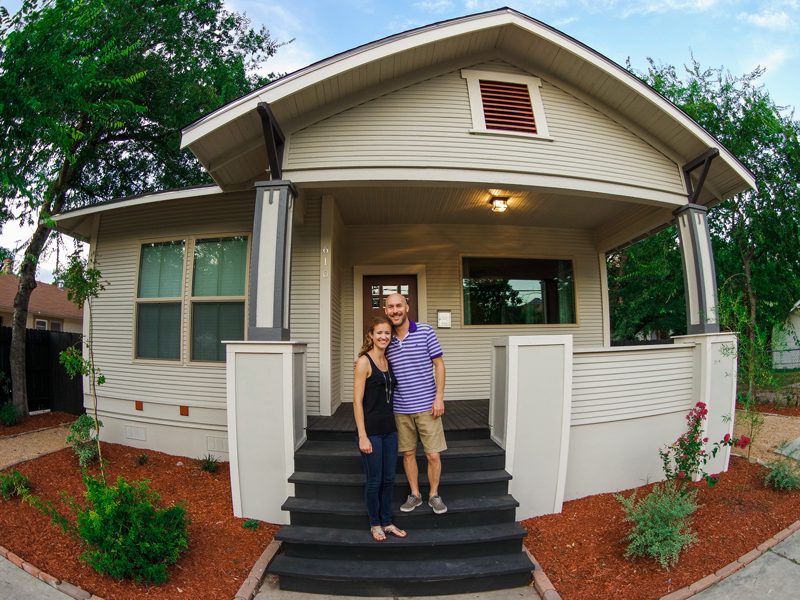How to Prepare for Big Home Purchases
photo by Nan Palermo
Congratulations! You’re a new home owner.
You’ve budgeted and saved for a down payment, and now you’re finally movin’ on up from your shoebox apartment to a comfortable split-level with room to grow. You thought of everything as you prepared for this huge accomplishment—except how to furnish your new house.
Did you know that some estimates place the cost of furnishing a home at roughly 25% of the home’s value? That’s more than most buyers have for their down payment! But fear not, there are things you can do to prepare for big home purchases, save some money, and even score home items for next to nothing!
1. Work with What’s There
Start simple and take an inventory of what you already have. During the home-buying process, you should have obtained an impartial inspection of the house, so you should have a good idea of the status of major appliances like the furnace and water softener. Adopt the “if it’s not broke, don’t fix it” mindset. Don’t waste time replacing perfectly good appliances if they are still reliable and functioning properly.
2. Prioritize What to Buy
Buying a new home is exciting, and it can be tempting to go crazy filling each room with furniture, decor, and personal touches. Before you go too overboard, reflect and identify the key pieces of furniture and appliances you need and want to buy first. Maybe your family life centers around entertaining and enjoying movies. If so, a new TV and couch might be high up on your list.
However, depending on how furnished the home was when you bought it, you might have to purchase necessities like a refrigerator, stove, or washer and dryer. Appliances like microwaves and dishwashers, while very convenient and nice to have, are not entirely necessary and can be prioritized lower.
Essential furniture items are things like beds and, at the very least, some chairs. Unless you prefer indoor camping on an air mattress, beds for every resident of the house should be prioritized over living room furniture. Go room to room making a list of needs, wants, and can-waits to help visualize what purchases to focus on.
3. Wait for Sales
Retailers live for three-day weekends, when they can slash prices on home goods in an effort to move inventory. Use this to your advantage and wait until your local big box store celebrates Memorial Day or Labor Day with a 50% off major appliances sale.
Keep an eye out for additional money-saving opportunities like zero interest or cash back on purchases. In-store credit cards are another way to enjoy discounts, since some retailers reward regular customers with exclusive savings. Some retailers even offer financing for people who don’t own credit cards.
4. Take Measurements
This might seem too obvious to forget, but plenty of eager homeowners have made hasty purchases only to find their new dining room table is too short or the stove too wide for the kitchen. Measure your available space, including doorways, and record the dimensions on a notecard or your phone for easy reference in the store.
Additionally, always clarify the return policy before you buy. The last thing you want is to blow your budget on an item, discover it won’t work for your home, and then find out you can’t return it.
5. Get Creative
Have an old dresser that’s seen better days? Repaint it, don’t replace it. You’ve just made a very large purchase (your house), so get creative with items still in decent shape. New paint or a new finish can really transform a piece of furniture and is more affordable than buying a brand new piece.
Here are some other creative ways to find home furnishings:
- Look for estate sales in your area and shop second hand or slightly used
- Search the postings of your local neighborhood for sale websites and online classifieds
- Check with the property manager of vacation apartments and condos to see if they’re willing to sell any items.
- Score heavily discounted items during floor model sales.
6. Be Reasonable
In addition to preparations like taking measurements, establish a budget and stick to it. Adjust your expectations to match your budget, and be reasonable about what you can purchase with the money available to you.
If you’re concerned about going over your limit or need help sticking to the plan, invite a trusted friend or family member to shop with you and help keep you on track. Don’t feel like you have to purchase everything at once, either. The process of furnishing a home is a journey and shouldn’t be rushed.
Bottom Line: Be Patient
Buying a home is a huge milestone—one many people work years to achieve. In addition to being an exciting time it can also be an overwhelming endeavor. Keep in mind though that you don’t need to buy every piece of furniture or make every update in the first year of ownership. Ideally, you have years ahead of you to transform your new house into a home. Take your time and use these tips to keep yourself calm and your budget intact.









